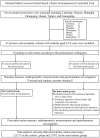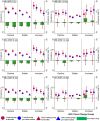National School-Based Health Lifestyles Intervention in Chinese Children and Adolescents on Obesity and Hypertension
- PMID: 34123956
- PMCID: PMC8192970
- DOI: 10.3389/fped.2021.615283
National School-Based Health Lifestyles Intervention in Chinese Children and Adolescents on Obesity and Hypertension
Abstract
Introduction: This study aimed to examine the effectiveness of the national school-based intervention on both obesity and high blood pressure in Chinese children and adolescents aged 6-18 years. Methods: The national school-based cluster non-randomized controlled trial was done in seven provinces from September 2013 to February 2014. A total of 23,175 children and adolescents in the control group and 25,702 in the intervention group were included in this trial with a mean follow-up of 6.7 ± 0.9 months. Mixed-effects regression models were used to evaluate the effect of the interventions on body weight and blood pressure (BP). Results: A significant upward in the body mass index (BMI) levels but downward in systolic BP (SBP), diastolic BP (DBP), BMI Z-scores, SBP Z-scores, and DBP Z-scores were witnessed in the intervention group compared to those in the control group (<0.001). Subgroup analyses presented significant intervention effects in children aged 6-12 years for BMI, SBP, DBP, and their standardized values Z-scores, but no effective results were found in adolescents aged 13-18 years. Stratification analyses based on the dynamic weight changes presented non-differential HBP, SHBP, and DHBP prevalence gaps between the control and intervention groups. Children aged 6-12 years with higher BMI percentiles at baseline presented obvious declines in SBP and DBP standardized values Z-scores. Conclusion: A mean 6-month multi-centered school-based comprehensive obesity intervention in China yields a small to null effect on obesity and hypertension with increasing age; the early age before 12 years may be the key period for interventions, and the younger, the better. Precise and high-intensity interventions targeting the population at different stages of childhood and adolescence are urgently needed to be developed. Clinical Trial Registration: https://www.clinicaltrials.gov/, identifier: NCT02343588.
Keywords: blood pressure; children and adolescents; intervention; non-randomized controlled trials; obesity.
Copyright © 2021 Dong, Zou, Wang, Dong, Hu, Ma, Song and Ma.
Conflict of interest statement
The authors declare that the research was conducted in the absence of any commercial or financial relationships that could be construed as a potential conflict of interest.
Figures





References
-
- NCD Risk Factor Collaboration. Worldwide trends in body-mass index, underweight, overweight, and obesity from 1975 to 2016: a pooled analysis of 2416 population-based measurement studies in 128.9 million children, adolescents, and adults. Lancet (2017) 390:2627–42. 10.1016/S0140-6736(17)32129-3 - DOI - PMC - PubMed
Publication types
Associated data
LinkOut - more resources
Full Text Sources
Medical
Miscellaneous

